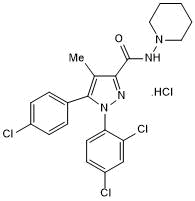SR 141716A
Tocris Bioscience, part of Bio-Techne | Catalog # 0923
Selective CB1 inverse agonist

Key Product Details
| Description: | Selective CB1 inverse agonist |
| Alternative Names: | Rimonabant hydrochloride |
| Chemical Name: | N-(Piperidin-1-yl)-5-(4-chlorophenyl)-1-(2,4-dichlorophenyl)-4-methyl-1H-pyrazole-3-carboxamide hydrochloride |
| Purity: | ≥98% (HPLC) |
| Molecular Weight: | 500.25 |
